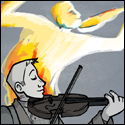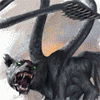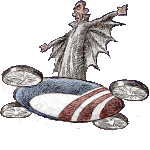|
Nihilarian posted:is that supposed to be 2e? Nope, that's 3e.
|
|
|
|

|
| # ? May 25, 2024 05:54 |
|
The first time I saw harm I was certain it was a misprint.
|
|
|
|
Olesh posted:Talking about Save or Suck spells getting better is disingenuous; Save vs Suck spells are better by comparison because damage spells got a whole lot worse and in the transition from 2E to 3E many spells had saving throws added to them. Save or suck spells weren't super common at all in 2E because there were a wealth of spell options that simply didn't allow a saving throw to begin with, and there were plenty of useful spells that offered substantial penalties to enemy saves. This isn't factoring in utility and buff spells, which as a general rule were often significantly better in 2E and typically had (sometimes significantly) longer durations. One of the many huge things you miss is how the saving throws changed and how much it is easier for a wizard with even half a brain to land a save or suck spell on just about any target. In AD&D there were five spell categories and the easiest saves were in the top category and hardest in the bottom two.. 1) Paralyzation, Poison, or Death Magic 2) Rod, Staff, or Wand 3) Petrification or Polymorph 4) Breath Weapon 5) Spell Let's rename that to something more functional: 1) Save or Die (Paralysis got moved here because it got followed with coup de grace too often) 2) Save vs Spell-in-a-can 3) Save or lose (but survive; polymorphed creatures can run and petrified ones are stone) 4) Save vs physical 5) Save vs magical If we look at a debilitating spell in AD&D like Stinking Cloud it was Save vs Poison. That made it a powerful spell but not terribly likely to succeed (most monsters, using the warrior saving throws, had +3 to save vs poison as against vs spells). The only real exception was PC wizards (who were very good at saving vs magic). Spell-in-a-can for what it's worth was always one point easier to save against than save vs spell in a can. Also this was particularly important at higher levels because you got better at saving against spells as you levelled up. Fireball was a good game at higher levels at least in part because it would always get damage through, and also because Then we hit 3.0 and it put the saving throws through a shredder. Spell saves became Fort/Ref/Will, and what that meant was that any sensible wizard got to pick the opponent's low defence. If you are facing goblins and wizards you know they have a low Fort so you break out Stinking Cloud, whereas for ogres it's Glitterdust because they have a low will. So a wizard should always be attacking the lowest magical defence of the target if they've prepared and have a clue about the situation. Working out which is lowest of Fort, Ref, and Will isn't generally hard - and there are save or suck spells in all three categories (although it's rarest in Ref) On that note in AD&D spell saving throws get better with level. In 3.0 spells get harder to save against as you level up - and do so at the same rate the best saves increase while low saves get left behind, and casters get to increase their casting stat to make the spells harder to save against. And before you say something about the changes to spell resistance, the conjuration school basically ignores spell resistance and has a lot of save or lose spells (as well as some direct damage). In 3.5 this also lets you basically ignore spell immunity while not having to change your spell loadout.
|
|
|
|
Gort posted:Nope, that's 3e. Also 3e: Hasted priest casts harm then clubs you with a +3 mace for the combo
|
|
|
|
harm then quickened cause light wounds so you don't ever have to hit their real AC
|
|
|
|
Gort posted:Nope, that's 3e. Bringing up Harm as if it's somehow new to 3E is my new favorite part of this conversation. Concentration - Your standard concentration bonus is your level + CON + 3, assuming you put points into it every level. There are a lot of concentration DCs for interfering with spellcasting (riding a horse, being in inclement weather) that are fixed, don't go up, and as such are or become trivial to make. However, there's two DCs we're really talking about here - the DC to cast defensively (and avoid provoking an attack of opportunity), and the DC to avoid your spell being interrupted from damage (such as when you take an attack of opportunity because you didn't cast defensively). Casting defensively is mostly a flat check - 15 + (2x spell level). It gets a little easier to cast your highest-level spells as your stats go up, but you need magic item assistance, Combat Casting, or both to negate the risk entirely. Interruption from damage is a variable check - 10 + spell level + damage taken. Early on, this is usually an "exceptionally easy" DC to make. Once you get to mid or high levels, when a single hit can do 20 or more damage? You aren't making a DC 40 or 50 check, you're dropping the spell. Sure, this was a change from 2E where any damage interrupted the spell. 2E had a bunch of ways to negate/avoid incoming attacks, though, so this was less of a deal than people make it out to be. Dangerous Spells: You're half wrong about polymorph spells; involuntary polymorph (i.e, Polymorph Other or Polymorph Any Object) is what had the system shock roll. A wizard using Polymorph Self or Shapechange was perfectly safe, no roll required. You bring up Wish aging the caster in 2E as if that restriction discouraged people from casting it more than the 25,000 XP cost in 3E. People used Wish all the time in second edition. In 3E? Players almost never cast it. Time restraints: Consider that a spell that lasts 1 round/caster level in either system lasts for, uh, 1 round per caster level. It's not as if suddenly buff spells get functionally shorter because 2E has a strange concept of how long one combat round is. 3E as well has spell durations measured in minutes (10 rounds per minute), 2E has durations measured in turns (10 rounds per turn), meaning that within the scope of combat, short duration spells are equivalent at best. Outside combat, well, your shortest duration spells in 3E are measured in seconds, and your shortest spells in 2E are measured in minutes. Consider what that means for buff durations. Personal Safety: Yes, wizards have substantially less HP in 2E. Actually, everyone had substantially less HP in 2E; wizards are most notable because having the lowest average hit die, they saw the biggest gains from a high constitution, especially as 3E meant that everyone could benefit from very high constitution and provided for magic items to boost said constitution values, increasing player HP further. You're also not mentioning that wizards, like everyone else, stopped rolling dice for HP and instead got fixed HP after a certain level (10th level for wizards), meaning that at best, your average HP for your swole wizard was 65hp at 20th level. You mention later on that HP values were lower across the board, but neglect to mention that damage and attacks are down in 2E, too. Wizards are squishy in 2E, and 3E, and don't stand up to a big bad carving them to pieces, except in 2E they're rather better at avoiding it - enemies are worse at hitting them, and there are a variety of means 2E wizards can use to negate damage or simply prevent enemies from having the opportunity to attack them in the first place. Preparing Spells: Whether this matters is really up to the DM. Maybe if you're in a game where significant time constraints upon your adventuring exist, then only spending an hour to memorize all your spells might matter, but spending a couple extra hours in camp whenever you need to replenish spells or a whole day if you've expended all your resources is unlikely to have any real effect. Learning Spells: Sure, this is more campaign dependent. 3E just gives you a couple spells of your choice every level and guarantees you'll eventually be able to buy scrolls to transcribe (they won't always be available when you look, but if you look enough times you'll find one). 2E explicitly gives the option to the DM whether or not you get new spells as you level up, have access to guilds or libraries where you can find and study spells, can return to your mentor periodically to obtain new spells, or have to get them as treasure. The worst case scenario has you forced to rely on random scrolls as treasure to transcribe into your spellbook, but this was by no means standard or mandatory. The standard response of "make your players go on an adventure to get <THING> that they want" is one that you'll see a lot in 2E, actually. Scrolls: Speaking of which, a 2E wizard can write scrolls and brew potions. It's explicitly a class feature! What are the rules? Well, the player must obtain ingredients (certain things they gather themselves increase the success chance) and then pass a percentile roll. What ingredients? Well, the DM determines the exact recipe - DMs who don't want to encourage magical item creation can simply make the recipes bizarre and fantastical, referencing mythical labours and ingredients. Alternatively, they can simply make recipes that are roughly appropriate to the desired item and leave the fantastical out of it, or reserve it only for rare and powerful items. The real difference between 2E and 3E is that 3E removes busywork from the DM - rather than 2E saying "okay, your players want to make a magic item? Sit down and design a recipe and maybe an adventure and figure out costs", 3E just turns around and says "okay, your players want to make a magic item? You need to approve it and they need to spend a certain amount of XP, GP, and meet the requirements listed on each item". Rulebook-wise, both systems are saying "Yes, this is a thing that you can freely do in the game unless your DM decides to not let you", but 3E just kind of goes "eh, whatever, they spend some resources to make this". For 2E? Consider making your players go on an adventure to get <THING> that they want instead. For your two real big ones, well... HP DAMAGE: Yes, HP values were substantially lower across the board. Non-caster damage values were also substantially lower. Not having adopted 3E's dumb "let's make monsters use the same stat line as PCs", 2E monsters have some interesting variety to them - hit chance, AC, and hit points don't have the huge swings between low-level and high-level monsters. 5E attempted to replicate and update this general feel of monsters not being tied to specific target metrics, where monsters aren't simply phased out due to becoming ineffectual. A monster that's dangerous at 10th level is generally still dangerous several levels later, and doesn't get or need increased hit chances, damage, or saving throws to do its job, unlike in 3E. Saving throws: Like with 2E, in 3E, ALL your saving throws go up as you level, but with 3E, saving throws are heavily modified by other things. What this means is that in practice, highly threatening monsters (who tend to have much more in the way of hit dice compared to the party) will tend to have saving throws that well outstrip the party's ability to increase their own DCs because they have good stats. From low levels, enemy saves start with a rough expected baseline of 50% (with good saves being more likely to succeed, and with bad saves being less likely) and then enemy hit dice and stats advance, on average, faster than the party. Even if you're targeting a "weak" save (like a dragon with its poor Dexterity), what this means in practice is that you're "only" dealing with a 60-70% chance of an at-level opponent making the saving throw, and wouldn't you know it, the "weak save" is Reflex, famously lacking in Save or Suck/Save or Die spells. This problem is only exacerbated when you're using anything other than your absolute highest level spells, as lower level spells have lower DCs. Sure, you might be able to more reliably disintegrate trolls or paralyze other chaff as you go up in level, but your chance of taking out the BBEG is abysmal. Compare this to second edition, though, and for the majority of a spellcaster's career, they're facing things with bad saving throws. Instead of a baseline 50% chance of success (modified by good/bad saves and stats), low-level monsters, low level monsters start with a 10% chance to make a saving throw and scale up from there. Many enemies that are still dangerous at high levels have lower hit dice and commensurately worse saving throws, and while high hit-dice enemies have great saves across the board in 2E, this is mitigated by the fact that a great many spells either apply a penalty to saving throws or simply don't allow a saving throw to begin with. These things exist in 3E as well, but, well, they exist now. There's been a few posts while I've been putting this effortpost together, people are clearly getting sick of this conversation, and I only have so much time I can spend writing posts and I have to draw the line somewhere... The long and short of it is, these issues didn't become magically more prevalent or worse in the transition to 3.X. They existed en masse in previous editions. The bevy of options to simply ignore saving throws, ignore spell resistance, kill/incapacitate one or more monsters by targeting a poor save (perhaps with a penalty to the saving throw), et cetera, were substantial, and were dramatically reduced with the release of 3E. 3.5 further attempted to rebalance and limit caster power, with some minor success. Over time, though, 3.X received a staggering amount of supplemental material, which added a great deal of additional options and power to casters, where many of these options opened back up with any sort of equivalence. Second edition had some amount of supplemental material which, don't get me wrong, did a whole lot to make casters more ridiculous than they already were, but in its lifespan had nothing like the explosive supplemental publishing and inevitable power creep that 3.X did. I've been discussing the systemic changes between 2E and 3E - things that were true on release and conversion to the new system, while the incoming arguments make quite liberal reference to things that only existed after the very expanded 3.X library of supplements. We're not really talking about the same thing here. Maybe it's pointless, since the relative limitations of spells and options I'm talking about were only true for a period of time until enough supplements were released, but that's a consequence of power creep. Regardless, I'm clearly making a clearly unpopular argument that people disagree with and people are tired of hearing it so I'll shut up now.
|
|
|
|
sick million words about a decades old argument between two non Pathfinder systems
|
|
|
|
I'm not gonna go through and dissect how you're wrong about literally almost everything, because 90% of your answers are "ok but what if the DM steps in?!" and yep, once again, this belongs in the Pathfinder thread.
|
|
|
|
This is what Harm does in AD&D 2e: This is what Harm does in D&D 3.0:  As you can see, it copies the AD&D 2e spell as close as it can, which actually speaks to the way that 3.0 was, in a sense, still trying to be an iterative, rather than evolutionary, change to D&D. Now, one of the things that doesn't really get a mention in the 3.0-to-3.5 transition is that the designers actually did learn a lesson about save-or-dies, to the extent that this is now what Harm looks like in D&D 3.5:  At the time, people did notice, so much so that Jonathan Tweet ended up writing this 2005 essay on hit-points and why it was necessary to try and steer the game back towards killing monsters by dealing damage through their HP (and allowing players to similarly not be instantly killed or neutered by monsters wielding similar spells). We know in practice that they weren't entirely successful at this, but they did take some steps towards it. EDIT: For what it's worth, the PF1e version of Harm is just a straight copy of 3.5's gradenko_2000 fucked around with this message at 05:31 on Sep 13, 2018 |
|
|
|
ProfessorCirno posted:I'm not gonna go through and dissect how you're wrong about literally almost everything, because 90% of your answers are "ok but what if the DM steps in?!" and yep, once again, this belongs in the Pathfinder thread. Thatís not what Olesh is saying at all. Theyíre pointing out in this last response that many things 3e has explicit frameworks for (like item creation) were instead constructed by DMs to taste using guidelines in 2e. Itís a fundamentally different thing about the two editions, and is worth bringing up when comparisons of the editions talk about related topics (like spell selection.) I donít necessarily agree with everything Olesh is saying but itís much better thought through and more comprehensive than you all are thinking. You seem to have this idea that 3e HAS to be the damned, broken child and showing where it wasnít quite that is a war crime or something. The point isnít that 2e or 3e donít have supreme wizards, itís that they both do, just in slightly different ways and 3e was following in 2eís footsteps when it constructed the systems it did. And I was going to bring it up but people already did - arguing about a generic 3e on this topic doesnít work great. 3.0, 3.5, and Pathfinder all have their own individual tweaks to make various spells and tactics better or worse.
|
|
|
|
Arivia posted:Thatís not what Olesh is saying at all. Theyíre pointing out in this last response that many things 3e has explicit frameworks for (like item creation) were instead constructed by DMs to taste using guidelines in 2e. Itís a fundamentally different thing about the two editions, and is worth bringing up when comparisons of the editions talk about related topics (like spell selection.) It's just factually untrue that 3E casters got stronger in few ways or have weaker options at their disposal. That's all there is to it. And we again step into non-situations like "What if their spells run out?" If the caster's spells run out, the adventuring day is over, or everyone dies because they don't have caster support. Real basic stuff. Most of us played a lot of 3E at one time and most of us are sick of it, but it just won't go away. Game design advanced a long way and D&D ultimately did not. Now I see stuff coming out of Paizo that I would compare unfavorably to 3E, because their design framework is just frozen in time and they spend oodles of design space solving for problems that better games have already solved. 3E had some big advancements over 2E and now we're just endlessly cycling on 3E, watching as Paizo struggles to "improve" the framework mainly by making it needlessly complicated, with manuals that are indistinguishable in structure and visual design from stuff written almost 20 years ago. It's stagnant.
|
|
|
|
I would ask if you have the same experience in either play or criticism with 2e that you do with 3e. Itís pretty obvious that Olesh knows 2e very well and is speaking from their experience with that system to make a comparison. Iím not sure if you have the same grounding. 3e wizard supremacy is such a common generally assumed truth in Internet discussion that Iím not sure youíre responding to him critically. I think thereís a lot of knee jerk automatic dismissal going on because someone critiquing the supremacy of wizards in 3e is taken as uninformed. Also Iíd give Paizo more credit than youíre giving them. Theyíve discussed how Pathfinderís design was intentionally conservative in the past, and their design in general tends more to the standard because thatís what they enjoy creating. 3.5 was more out there because Wizards intentionally was designing more out there things in a way Paizo doesnít. (And also check out Pathfinder 2e of course.)
|
|
|
|
"Olesh's argument is clearly based on actual experience while everyone else in the thread clearly gets all their opinions from the internet and doesn't play the game" Is that the gist of your statement Arivia?
|
|
|
|
Terrible Opinions posted:"Olesh's argument is clearly based on actual experience while everyone else in the thread clearly gets all their opinions from the internet and doesn't play the game" With regards to 2e in particular? Yes. Obviously people in here play 3e/PF, but only playing part of the comparison doesnít make you well equipped to consider all of it.
|
|
|
|
Oh my bad, I didn't know my own time spent playing 2e never happened, I should've checked with you first those decades ago to make sure they were legit.
|
|
|
|
I'm going to be honest having played quite a bit of 2nd edition myself he's still wrong.Olesh posted:Concentration - Your standard concentration bonus is your level + CON + 3, assuming you put points into it every level. There are a lot of concentration DCs for interfering with spellcasting (riding a horse, being in inclement weather) that are fixed, don't go up, and as such are or become trivial to make. However, there's two DCs we're really talking about here - the DC to cast defensively (and avoid provoking an attack of opportunity), and the DC to avoid your spell being interrupted from damage (such as when you take an attack of opportunity because you didn't cast defensively). The only game I can think of where you wouldn't consider a 75% or 90% chance of success up form a 0% chance of success to be a massive buff is in XCOM where those numbers are all identical. Olesh posted:Dangerous Spells: You're half wrong about polymorph spells; involuntary polymorph (i.e, Polymorph Other or Polymorph Any Object) is what had the system shock roll. A wizard using Polymorph Self or Shapechange was perfectly safe, no roll required. You bring up Wish aging the caster in 2E as if that restriction discouraged people from casting it more than the 25,000 XP cost in 3E. People used Wish all the time in second edition. In 3E? Players almost never cast it. Olesh posted:Outside combat, well, your shortest duration spells in 3E are measured in seconds, and your shortest spells in 2E are measured in minutes. Consider what that means for buff durations. Olesh posted:Wizards are squishy in 2E, and 3E, and don't stand up to a big bad carving them to pieces, except in 2E they're rather better at avoiding it - enemies are worse at hitting them, and there are a variety of means 2E wizards can use to negate damage or simply prevent enemies from having the opportunity to attack them in the first place. Olesh posted:Saving throws: Like with 2E, in 3E, ALL your saving throws go up as you level, but with 3E, saving throws are heavily modified by other things. What this means is that in practice, highly threatening monsters (who tend to have much more in the way of hit dice compared to the party) will tend to have saving throws that well outstrip the party's ability to increase their own DCs because they have good stats. From low levels, enemy saves start with a rough expected baseline of 50% (with good saves being more likely to succeed, and with bad saves being less likely) and then enemy hit dice and stats advance, on average, faster than the party. Even if you're targeting a "weak" save (like a dragon with its poor Dexterity), what this means in practice is that you're "only" dealing with a 60-70% chance of an at-level opponent making the saving throw, and wouldn't you know it, the "weak save" is Reflex, famously lacking in Save or Suck/Save or Die spells. This problem is only exacerbated when you're using anything other than your absolute highest level spells, as lower level spells have lower DCs. Sure, you might be able to more reliably disintegrate trolls or paralyze other chaff as you go up in level, but your chance of taking out the BBEG is abysmal.
|
|
|
|
3E casting defensively was actually 15 + SL, not + 2*SL. So on its own it didn't scale too hard, but add to that the concept of the five-foot step (which seriously got the joking nickname of "munchkin moonwalk") and suddenly it was very hard to hold down a caster who didn't want to be held down. PF took away Concentration as a skill but it mostly works the same there. Casting defensively might be harder...but as I said you also have the five-foot step to not roll in the first place.
|
|
|
|
You know I just took his word on that, which in retrospect I shouldn't have. So yeah it is trivial to auto succeed even if you're in the thick of it even without the 5 foot step. The highest you could possibly need is 24.
|
|
|
|
ProfessorCirno posted:Oh my bad, I didn't know my own time spent playing 2e never happened, I should've checked with you first those decades ago to make sure they were legit. Itís funny how you and the others didnít bring any familiarity with 2e up until now and were just focused on circling the wagons around 3e. Weird way of showing that play experience, Cirno.
|
|
|
|
Arivia posted:Itís funny how you and the others didnít bring any familiarity with 2e up until now and were just focused on circling the wagons around 3e. Weird way of showing that play experience, Cirno. Yeah it isn't as if literally just last page I had a giant post comparing the rules of 2e and 3e, that could've been helpful. Clearly I just avoided saying the magic words of "In my experience" to set up this cunning snare you've fallen for!
|
|
|
|
Why do you keep pulling "not a real gamer" defenses on everything, Arivia? Is your night job making videos about how WotC has ruined mtg by selling out to the SJWs?
|
|
|
|
I mean, my experience of actual 2E is nil but I'm guessing that the Infinity Engine games were enough of a surface-level approximation that you can guess some of the rough bits like how HP scaled versus damage (especially how warriors had about double the health of wizards) or how saves scaled at a more consistent rate in 2E than in 3E. But also there's the subtle fact that even Olesh is admitting that a lot of the potential concessions to casters were opt-in in 2E rather than opt-out in 3E. The default assumption of "how do I get new spells" being "do a quest or ask the GM nicely to have it show up in loot" sets different expectations than "you can just pick it on level-up or find it somewhere in the nearest city", even if the GM wants to be accommodating.
|
|
|
|
* The Combat Casting feat gives you a +4 to Concentration checks when Casting Defensively, so you could have a 60% chance to succeed on Casting Defensively checks by as soon as level 1. Casting Defensively would be impossible to fail by character level 15 with 18 ranks + Combat Casting, and that's two whole levels before a Wizard even learns how to cast 9th-level spells in the first place, and that's all if we're assuming 10 Constitution. * As far as saving throws, an analysis of PC spell DCs versus monster saving throws shows that there's a consistent 60% chance for the monster to make the save if you're targeting their "Good" save, and a consistent 35% chance for the monster to make the save if you're targeting their "Bad" save:  And, mind you, this is assuming that the encounters are based on "Character Level = Monster CR", which isn't supposed to happen all that often per action economy and encounter creation guidelines - you're more likely to encounter monsters some 2 to 3 CRs lowers than your Character Level, which makes saving throw failures even more likely. Let's a take a level 10 Wizard: 20/+5 Intelligence, Spell Focus, and a 5th-level spell comes out to a spell DC of 21. If you pit them against a CR 6 Ettin (where CR 6 is the about what you'd need to maintain numerical parity with the PCs when constructing encounters), the Ettin is going to pass its +9 Fort save 45% of the time, and it's going to pass its +5 Will save against the same DC at just 25% of the time, and it's never going to pass with a +2 Reflex save. (and, if you look back at the chart above, CR 6 does assume a Good save of +9, which is the Ettin's Fort save, and a Bad save of +4, which splits the difference between the Ettin's Will and Reflex saves) If we take this back to AD&D 2e: an Ettin has 10 HD, which means it rolls its saves like a level 10 Warrior. That comes out to a target number of 11 for Save vs Spell as the "worst" save, and a target number of 8 for Save vs Paralyzation, Poison, or Death Magic. That means that the Ettin is going to succeed at Save vs Spell, 50% of the time, and it's going to succeed at Save vs Paralyzation, etc., 65% of the time. There's really no contest. Monsters absolutely lost ground to casters when it comes to saving throws, because requiring saving throws to "scale with stats" invariably caused some saving throws to become worse, because every creature is constructed with some stats as being deliberately bad.
|
|
|
|
ProfessorCirno posted:Yeah it isn't as if literally just last page I had a giant post comparing the rules of 2e and 3e, that could've been helpful. Clearly I just avoided saying the magic words of "In my experience" to set up this cunning snare you've fallen for! Cirno a bunch of hazy unspecified comparisons are no comparison at all. You werenít showing off any more knowledge than a cursory skim of the core rulebooks (in contrast to Oleshís specificity.) What did ďThink about what that means for buff durations.Ē actually mean? Itís not an argument, itís barely a half-completed thought. So if you do have experience it wasnít showing. I could have made a similar post and I never played 2e as an actual, formed game. That said, Iím just posting about posting and donít have anything else to add, so Iíll shut up.
|
|
|
|
The change in casting time is significant. The 2e spell takes a full round - lots of chances for that to be stopped. The 3e one task knees one action.
|
|
|
|
Arivia posted:Cirno a bunch of hazy unspecified comparisons are no comparison at all. You werenít showing off any more knowledge than a cursory skim of the core rulebooks (in contrast to Oleshís specificity.) What I took from the "Think about what that means for buff durations" is that long term buffs or buffs with fixed duration were consumed much faster by the minute long rounds of combat as opposed to the six second rounds of combat. While the majority of buffs are measured by the round in 2e, there are a fair number of buffs in 3e that have long fixed duration or duration measured in minutes per level. Combined with the shorter round length, you can easily stretch powerful buffs across multiple combats essentially getting extra uses of the spell, while in 2e they were usually enabled for a single fight.
|
|
|
|
Arivia posted:Cirno a bunch of hazy unspecified comparisons are no comparison at all. You werenít showing off any more knowledge than a cursory skim of the core rulebooks (in contrast to Oleshís specificity.) Given that RAW analysis is the only way to really compare systems in any sort of Apples-to-apples way, then merely reading the books is a perfectly acceptable way of comparing two systems. It's academic criticism. Comparisons based on personal play experience are utterly meaningless as it turns an objective comparison into a subjective one so trotting that out is just a way to move the goal posts and avoid actually engaging in the argument. Any play experience comparisons can really only be done in exercises of fully optimal, fully sub-optimal, or "average" roll measures like Gradenko did.
|
|
|
|
Everyone knows the only way to objectively analyze rpg rules is by trying to reenact them in real life using objects from your computer desk, like a mouse and its cord
|
|
|
|
Xelkelvos posted:Given that RAW analysis is the only way to really compare systems in any sort of Apples-to-apples way, then merely reading the books is a perfectly acceptable way of comparing two systems. It's academic criticism. Comparisons based on personal play experience are utterly meaningless as it turns an objective comparison into a subjective one so trotting that out is just a way to move the goal posts and avoid actually engaging in the argument. Any play experience comparisons can really only be done in exercises of fully optimal, fully sub-optimal, or "average" roll measures like Gradenko did. The idea of "rules as written" is a bullshit fiction coaxed up by people who don't actually understand the mechanism of reading and how that relates to playing the actual game. Academic criticism would be much stronger than the kinds of idiocy the 3e/PF rules community comes up with. You using "apples to apples" as a phrase for comparison shows that you don't really have any idea of how to compare two texts and need to shut up. If you're going to read the rulebooks and form an argument based off of those, make a proper close reading. If you're going to form an argument based off of gameplay, of course you return to the actual play experience because that experience is the result of interpreting and retransmitting the text to others in the game. You cannot understand or criticize the game without playing the game because play is the method through which the game creates meaning. edit: It's pretty much a cargo cult, really. People following after people, none of them knowing how to critically read a text and question it. Without any understanding, they fumble at their own terminology without examining its assumptions and lash out at others who disrupt the group superstition.
|
|
|
|
Archives of Nethys is becoming the official source for the Pathfinder and Starfinder Resource Documents: http://paizo.com/community/blog/v5748dyo6sg93?Big-PathfinderStarfinder-Reference-Document-News This is pretty much cutting the d20pfsrd guy out of the loop and I'm okay with that. His site was really bad and became worse and worse.
|
|
|
|
Arivia posted:edit: It's pretty much a cargo cult, really. People following after people, none of them knowing how to critically read a text and question it. Without any understanding, they fumble at their own terminology without examining its assumptions and lash out at others who disrupt the group superstition.
|
|
|
|
Ahhh, the ardent supporter of Rules as Experienced. Would it be the case then that a game cannot be judged as good or bad without actual play given that comparisons cannot be done without actually playing the game? Follow up: Is FATAL a good game? I clearly cannot judge it as I have not had the honor of playing it and merely looking at the rules is apparently insufficient in this determination.
|
|
|
|
NGDBSS posted:
Do you have a degree in cultural studies? I'm not the principle (or sole) authority, but I'm definitely willing to call out pointless, baseless community folklore that doesn't stand up to actual learned critical analysis. If you don't have a degree, that's fine - but do realize you don't have explicit learning about the subject in discussion. Also, RPG books aren't technical manuals because they are texts creating fiction either through reading or gameplay. That's not a technical work.
|
|
|
|
Xelkelvos posted:Ahhh, the ardent supporter of Rules as Experienced. Would it be the case then that a game cannot be judged as good or bad without actual play given that comparisons cannot be done without actually playing the game? Correct. quote:Follow up: Is FATAL a good game? I clearly cannot judge it as I have not had the honor of playing it and merely looking at the rules is apparently insufficient in this determination. I don't know if FATAL is a good game or not. People generally don't discuss it as a game though - they do read the text and discuss the racist, noxious, and otherwise disgusting elements of the text. And you can make a decision about the text based off of that reading, so we can say that FATAL is disgusting and isn't enjoyable to read. You can extend this and say that FATAL is likely not good or fun to play because the text is so vile that interacting with it is abhorrent as the first step of the action of play (interpreting the rules before retransmitting them in play.) That suggestion isn't actual play experience, and shouldn't be treated as such, but it's an okay starting point for personal decisions about the game. You're getting it though! Go you!
|
|
|
|
Arivia posted:Do you have a degree in cultural studies? I'm not the principle (or sole) authority, but I'm definitely willing to call out pointless, baseless community folklore that doesn't stand up to actual learned critical analysis. If you don't have a degree, that's fine - but do realize you don't have explicit learning about the subject in discussion. The systemized act of generating a character, numerically generating their abilities and resolving conflict is 100% what makes it a technical work as any other board game rule book or CCG manual. That a narrative can also be generated from what is essentially a technical document is just part of its design goal rather than a side effect. That the rules for the generation of narrative and the mechanical rules are woven together so as to sometimes be seemingly inseparable is merely of the writer's doing rather than definitive of the nature of the document itself. As it's written, it's a technical document. At least, to my definition of one. To yours, idk. To your response about FATAL, that's literally "I don't know, but based on reading it, probably, yes." I've read through the rules enough that, without play, and even ignoring the more obscene parts, it's still a bad game because the character generation mechanics are convoluted dogshit and the resolution mechanics are inane. You don't need to actually play the game to run through how the rules interact as RAW and see where the gears mesh or lock up.
|
|
|
|
Xelkelvos posted:The systemized act of generating a character, numerically generating their abilities and resolving conflict is 100% what makes it a technical work as any other board game rule book or CCG manual. That a narrative can also be generated from what is essentially a technical document is just part of its design goal rather than a side effect. That the rules for the generation of narrative and the mechanical rules are woven together so as to sometimes be seemingly inseparable is merely of the writer's doing rather than definitive of the nature of the document itself. As it's written, it's a technical document. At least, to my definition of one. To yours, idk. Using "RAW" as a term again shows that you haven't paid any attention to what I'm saying so I'll just leave it here. You've bought too much into that cargo cult to be willing to think outside of it or argue its merits, and that's on you, not me.
|
|
|
|
Pathfinder RPG: Do you have a degree in cultural studies?
|
|
|
|
Arivia posted:Do you have a degree in cultural studies? I'm not the principle (or sole) authority, but I'm definitely willing to call out pointless, baseless community folklore that doesn't stand up to actual learned critical analysis. If you don't have a degree, that's fine - but do realize you don't have explicit learning about the subject in discussion. And when you follow it up with the auteur-director canard of "you cannot truly evaluate a work without experiencing it first", well that's basically apologist nonsense. Any given playgroup is going to be skewed in one direction or another, and even playtesting scenarios have to establish a lot of control (including but not limited to "try to break this game") over multiple tables to get meaningful feedback. Your perception of D&D as played isn't going to be the same as anyone else's, and if we attempt to use that as a standard for evaluating the rules we have no common baseline. This isn't a new argument; I remember seeing it come up back when 339 (the old 3E Character Optimization boards) was active. Working with the rules text as written is the only meaningful baseline we have, short of telepathy. We can certainly move forward from said baseline because every table is different, but if we abjure that initial business of "here is what the rules say; do we want to alter them" then our whole premise for discussion is shot. Our argument is unsound, as it were.
|
|
|
|
Arivia posted:Archives of Nethys is becoming the official source for the Pathfinder and Starfinder Resource Documents: http://paizo.com/community/blog/v5748dyo6sg93?Big-PathfinderStarfinder-Reference-Document-News Yeah, it's just gotten more and more out of date, but some of the search tools and formatting are still better on d20pfsrd. I use both sites for the things that they are better at than the other. (Example: d20 for spells, Archives for archetypes.)
|
|
|
|

|
| # ? May 25, 2024 05:54 |
|
Has anyone here actually acted in a Shakespeare play? Iím looking for authorities to tell me which are the best ones.
|
|
|





























